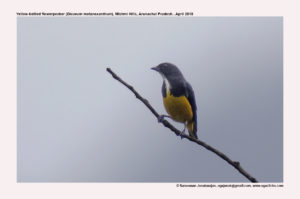Yellow-bellied Flowerpecker

Yellow-bellied Flowerpecker Dicaeum melanoxanthum
Etymology:
- Dicaeum: Greek word dikaion supposedly an Indian bird
- Melanoxanthum: Greek Word melas –black; xanthos –
Distribution in India: Resident of Eastern Himalayas and hills of North East India.
Description: Size of 11·5–13 cm. The male has head and upperparts slaty blue-black with slight gloss, upperwing and tail is black, two outer pairs of tail feathers have large white patch on inner web. The outermost primary is not vestigial but short. The centre of throat and upper breast are white, sides of neck and of breast are dull greyish-black, rest of underparts are bright yellow; iris is red or chestnut; upper mandible is black, lower mandible is grey; legs are black. The female is duller than male, has head, side of neck and upperparts as olive-grey, centre of throat and breast are white, centre of belly and undertail-coverts are pale yellow, flanks are olive-yellow, has less white on tail. The juvenile is mostly dull brown, with hint of white on throat and yellow on belly. The immature male is duller than adult, with brownish-grey upperparts.
Habitat: It is found in pine forest, in tall trees of open forest, clearings in rainforest and at forest edge. It is found from 1400–3915 m in summer, and 775–1550 m in winter.
Food habits: It eats insects, fruit, nectar and pollen, and in winter some leaves of mistletoes. It is solitary, elusive, and more sluggish than smaller congeners. It sits upright on exposed perch often for lengthy periods. It flycatches by sallying.
Breeding habits: They breed in Apr in Myanmar, Jun in India and Jul in Nepal. They lay a clutch of 3 eggs.